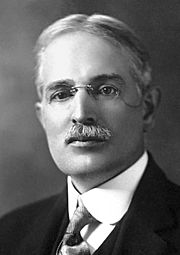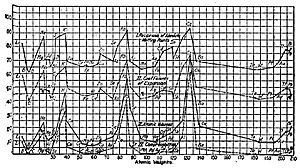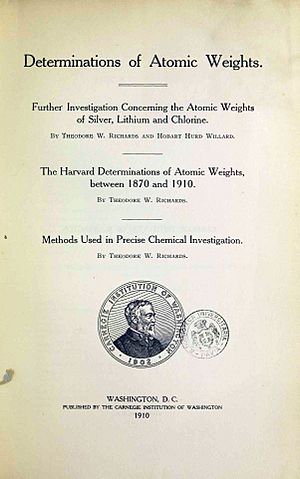Theodore William Richards facts for kids
Quick facts for kids
Theodore William Richards
|
|
|---|---|

Richards in 1914
|
|
| Born | January 31, 1868 |
| Died | April 2, 1928 (aged 60) |
| Nationality | American |
| Education | Haverford College Harvard University |
| Known for | Atomic weights Thermochemistry Electrochemistry |
| Awards | Davy Medal (1910) Willard Gibbs Award (1912) Nobel Prize for Chemistry (1914) Franklin Medal (1916) |
| Scientific career | |
| Fields | Physical chemistry |
| Institutions | Harvard University |
| Doctoral advisor | Josiah Parsons Cooke(see Kopperl: "Theodore W. Richards: America's First Nobel Laureate Chemist", in Profiles in Chemistry, in Journal of Chemical Education, 1983, Vol. 60, Issue 9, page 738. |
| Doctoral students | Gilbert N. Lewis Farrington Daniels Malcolm Dole Charles Phelps Smyth Hobart Hurd Willard |
Theodore William Richards (January 31, 1868 – April 2, 1928) was a very important American scientist. He was the first American to win the Nobel Prize in Chemistry. He received this award because he was incredibly accurate in figuring out the atomic weights of many different chemical elements.
Contents
Early Life and Education
Theodore Richards was born in Germantown, Pennsylvania, on January 31, 1868. His father, William Trost Richards, was a painter. His mother, Anna Matlack Richards, was a poet. Theodore learned most of his early lessons from his mother at home.
One summer, while staying in Newport, Rhode Island, Theodore met Professor Josiah Parsons Cooke from Harvard University. Professor Cooke showed the young Theodore Saturn's rings through a telescope. Years later, Theodore would work with Professor Cooke in his laboratory.
In 1878, when Theodore was 10, his family spent two years in Europe, mostly in England. During this time, his interest in science grew much stronger. After returning to the United States, he started Haverford College in Pennsylvania in 1883, at just 14 years old. He earned a Bachelor of Science degree in 1885.
He then went to Harvard University and earned a Bachelor of Arts degree in 1886. This helped him prepare for his advanced studies.
Career at Harvard
Richards continued his studies at Harvard. His main research for his doctorate was about finding the atomic weight of oxygen compared to hydrogen. Professor Josiah Parsons Cooke was his advisor.
After finishing his studies, Richards spent a year in Germany. He studied with famous scientists like Victor Meyer at the University of Göttingen. When he came back to Harvard in 1889, he started as an assistant in chemistry. He then became an instructor, an assistant professor, and finally a full professor in 1901.
In 1903, he became the head of Harvard's Chemistry Department. In 1912, he was named the Erving Professor of Chemistry. He also became the Director of the new Wolcott Gibbs Memorial Laboratory.
Personal Life and Interests
In 1896, Richards married Miriam Stuart Thayer. They had one daughter, Grace Thayer, and two sons, Greenough Thayer and William Theodore. Grace later married James Bryant Conant, who became president of Harvard.
Richards enjoyed art and music. For fun, he liked sketching, playing golf, and sailing. He died in Cambridge, Massachusetts, on April 2, 1928, when he was 60 years old. He was a Quaker.
Scientific Discoveries
About half of Theodore Richards's scientific work was focused on finding atomic weights. He started this research in 1886 and continued it throughout his life. By 1932, Richards and his students had studied the atomic weights of 55 different chemical elements.
Richards discovered that some substances could trap gases or other materials when they formed. This could make their atomic weight measurements incorrect. He was very careful in his work. For example, he purified a substance called thulium bromate 15,000 times. He did this to get pure thulium for an accurate atomic weight measurement.
Richards was the first scientist to show that an element could have different atomic weights. He studied samples of lead found in nature and lead created from radioactive decay. His measurements showed that these two types of lead had different atomic weights. This discovery helped support the idea of isotopes. Isotopes are different forms of the same element that have different masses.
Today, scientists use modern tools like mass spectrometers to find atomic weights. These tools can measure the masses of an element's isotopes and how much of each isotope is present. From this information, they can calculate the average atomic mass. These modern methods are faster and more sensitive than the ones Richards used.
Richards also studied how much atoms can be compressed. He looked at the heat released when substances dissolve or react. He also researched how electricity works with certain metal mixtures called amalgams. His work on electrical potentials at low temperatures helped other scientists develop important ideas like the Third law of thermodynamics.
Richards also invented some important lab tools. He created the adiabatic calorimeter, which measures heat changes very accurately. He also invented the nephelometer, which measures how cloudy a liquid is. He used the nephelometer for his work on the atomic weight of strontium.
Awards and Recognition
Theodore Richards received many honors for his important scientific work:
- Member of the American Philosophical Society (1902)
- Lowell Lectures (1908)
- Davy Medal (1910)
- Faraday Lectureship (1911)
- Willard Gibbs Medal (1912)
- President of the American Chemical Society (1914)
- Nobel Prize in Chemistry (1914)
- Franklin Medal (1916)
- President of the American Association for the Advancement of Science (1917)
- Honorary Member of the Royal Irish Academy (1918)
- Foreign Member of the Royal Society of London (1919)
- President of the American Academy of Arts and Sciences (1919 – 1921)
- Lavoisier Medal (1922)
- Le Blanc Medal (1922)
- Honorary Fellow of the Royal Society of Edinburgh (1923)
- Member of the International Atomic Weights Committee
- Theodore Richards Medal (1932, awarded after his death)
Selected Writings
See also
 In Spanish: Theodore Richards para niños
In Spanish: Theodore Richards para niños



